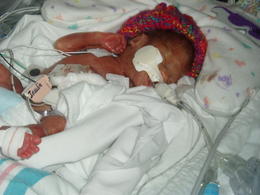Entry for December 29, 2005
Pulmonary Interstitial Emphysema Background: Pulmonary interstitial emphysema (PIE) is an iatrogenic pulmonary condition of the premature infant with immature lungs. PIE occurs almost exclusively with mechanical ventilation. The ventilator pressure used to keep the alveolar ducts open also may cause rupture of the alveolar duct (usually at the junction of the bronchiole and alveolar duct) and consequent escape of air into the pulmonary interstitium, lymphatics, and venous circulation.Pathophysiology: Immature lungs are underdeveloped and lack adequate surfactant to keep the alveolar ducts and early alveoli open on inspiration and expiration. The resulting diminished surface for transfer of gas and widespread atelectasis leads to inadequate transfer of carbon dioxide and oxygen across the epithelial surfaces to the pulmonary microvascular system. Methods to improve oxygen saturation include administering high concentrations of oxygen and expanding and maintaining that expansion of gas-exchanging surfaces of the lung using high levels of inhaled oxygen and positive pressure ventilation. Excessive intra-airway pressure may lead to leak from the alveolar ducts (primordial acini) into the lung interstitium. Once in the interstitium, the gas is picked up in the rich lymphatic network of the neonate and carried toward the pleural lymphatics and central bronchopleural lymphatics. PIE usually occurs early during ventilation, and most infants present in the first 72 hours with this abnormality. It is observed less frequently now because of treatment of immature babies with exogenous surfactant, which improves compliance of the lung (thus less ventilatory pressure is needed) and keeps the alveolar ducts open during both inspiration and expiration. It also assists in the recruitment of alveolar ducts to prevent areas of overinflation and underinflation. Currently, PIE is seen more often in infants on long-term ventilator therapy with uneven aeration and bronchopulmonary dysplasia (BPD) leading to air trapping and potential airspace rupture.Frequency: * In the US: Several decades ago, PIE was a common occurrence in infants with severe respiratory distress on ventilators. Currently, it is an uncommon occurrence because of treatment with surfactant and gentle ventilation as well as the availability of high-frequency oscillatory ventilation for infants who are difficult to maintain with conventional%2
Subscribe to:
Post Comments (Atom)








No comments:
Post a Comment